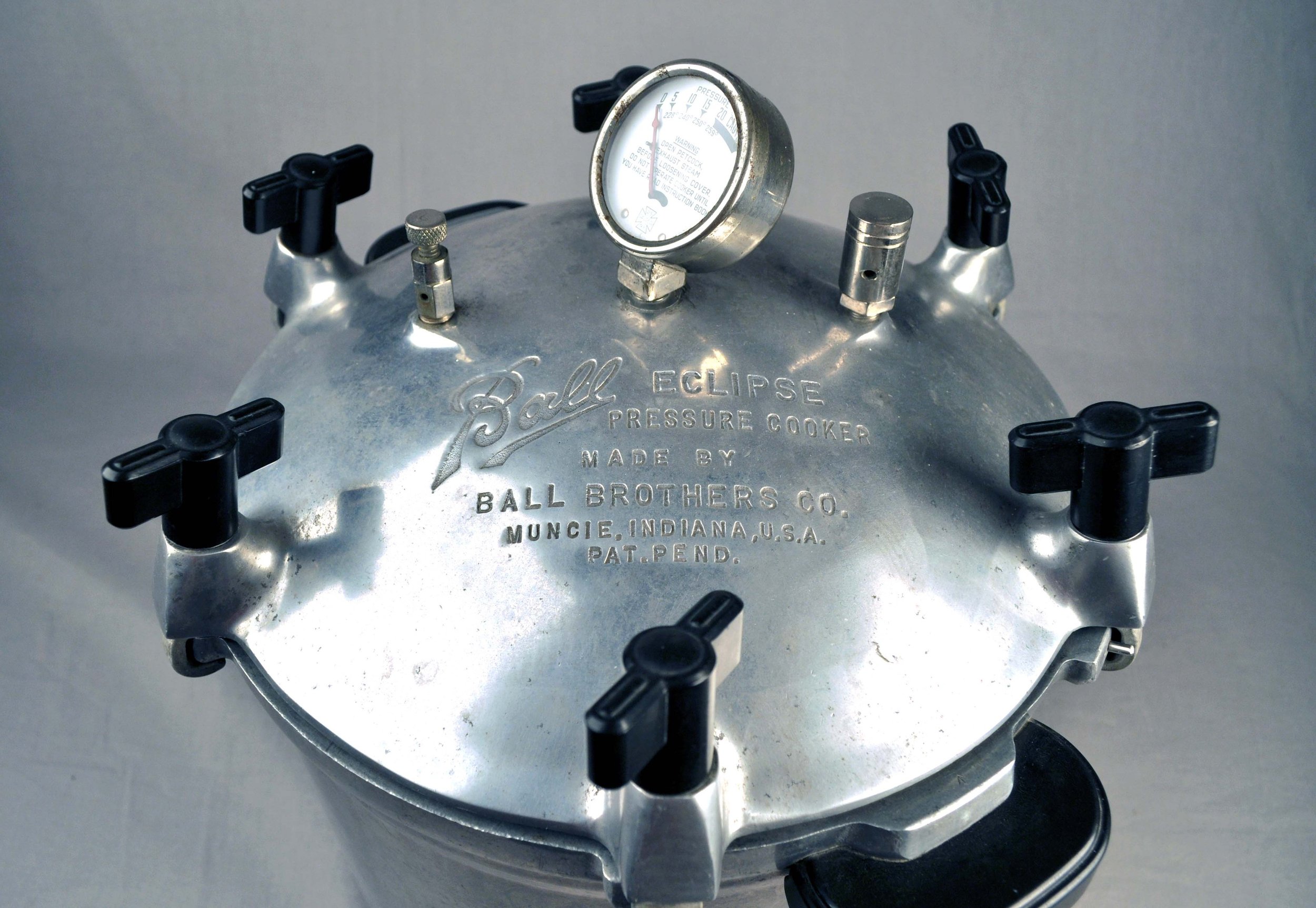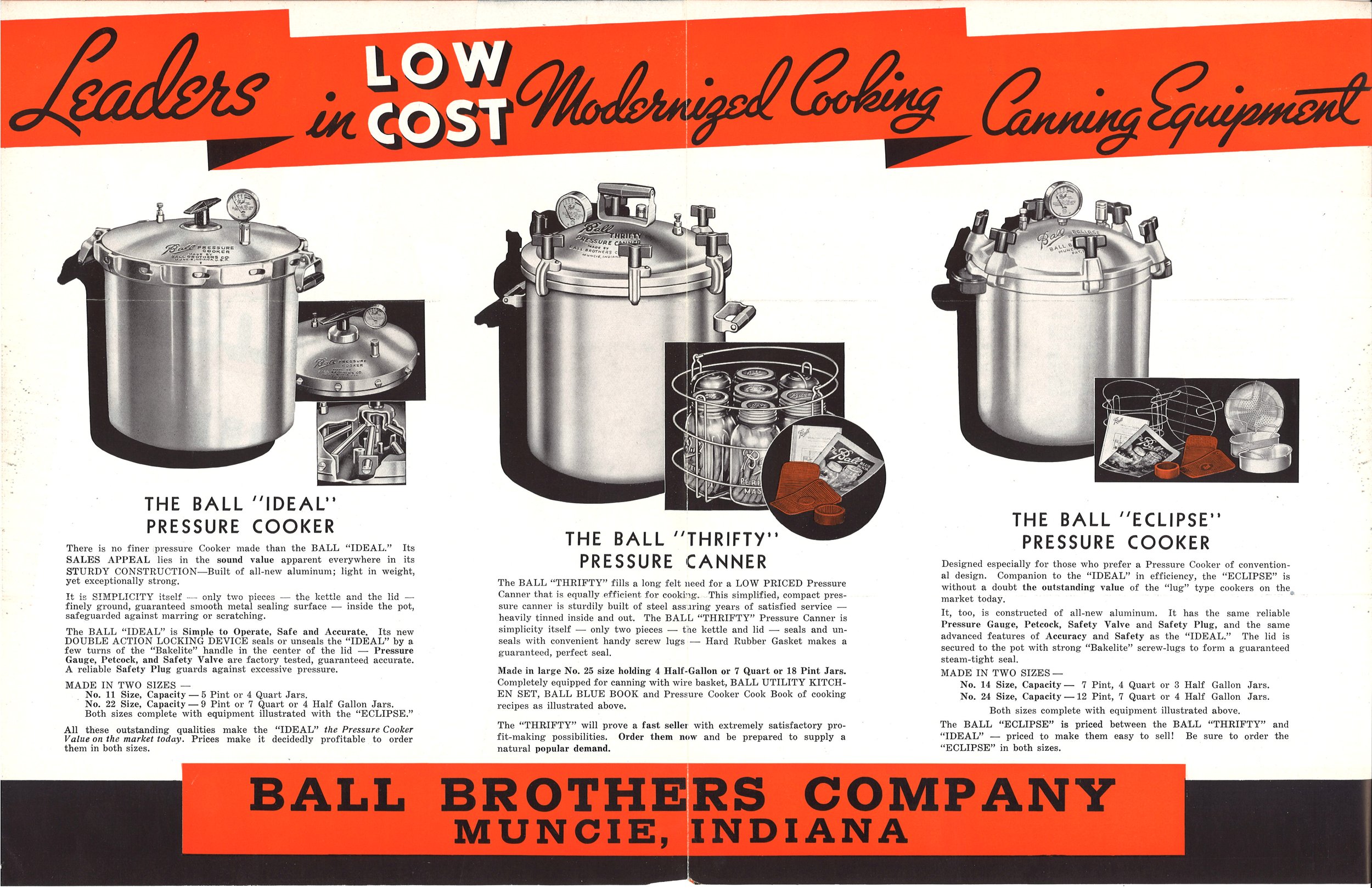Pressure Cookers Come and Pressure Cookers Go
As with all successful entrepreneurs, the Ball brothers were innovators who were not averse to taking risks. They embraced the idea of new products and in the early 1930s decided that manufacturing pressure cookers might not be a bad idea. After all, pressure cookers-canners were a natural extension of the fruit jar industry.
The timing seemed to be auspicious. The Chicago World’s Fair, A Century of Progress, was scheduled to adorn the Lake Michigan shoreline from 1933 to 1934. What a perfect time to introduce a new product: the Ball “Ideal” Pressure Cooker.
In preparing this new product for sale, the company took advantage of its ties to Ball State Teachers College to enlist the Home Economics Department for assistance. Students were asked to experiment with a new method of canning meat using a pressure cooker. Of course, Ball paid for all the materials.
By 1934, Ball Brothers had taken orders for 150 “Ideal” pressure cookers. At first, production started on a limited scale. The aluminum pressure cookers, which had a double-action locking device, were made in the Ball machine shop. They came in two sizes: the Number 11 Size which held five-pint jars or four-quart jars and sold for $16.95 and the larger Number 22 Size which could accommodate nine-pint Ball jars, seven quarts, or four half gallons and retailed for around $21.95.
Ball Ideal
Ball Ideal
Now let’s stop a moment and take a quick look back into history. In 1906, Alvah Bingham (a cousin of the Ball brothers), Frank Burt, Cary Crozier, H. P. Gerdau, W. H. Moon, John Stetter, and Fred Kaiser filed articles of incorporation for the Machinists Foundry Company. The company was formed to turn out castings for Ball Brothers Glass Manufacturing Company. Later Ball Brothers sold a piece of land by their factory to the new company for $1.00.
When it became apparent that it was time for Ball pressure cookers to go into full production, the company looked for somewhere to locate a new plant. The answer was right under their noses: the Machinists Foundry Company. Ball bought the foundry in the summer of 1934 for – you guessed it – $1.00. The pressure cooker plant then moved into Building 27, which was a part of the recently purchased property. Building 27 was situated on Macedonia Avenue between the Stamping Department and the Zinc Rolling Mill.
In January 1935, the company was ready to go into full production. Aluminum castings were still purchased for the bodies and lids, but the machine shop had designed and built automatic machines which turned the castings into finished pressure cookers.
1935 was also the year for the introduction of the second pressure cooker in the Ball line, the more traditional Ball “Eclipse.” The Ball “Ideal” sealed and unsealed by turning the Bakelite handle in the center of the lid. The aluminum “Eclipse” was secured with six evenly spaced Bakelite screw lugs. The Number 14 Size had room for seven pints, four quarts, or three half gallons. The larger Number 24 Size held twelve pints, seven quarts, or four half gallons. Both the “Ideal” and the “Eclipse” came equipped with a bottom rack, solid and perforated pans, and a wire rack for holding the jars.
Ball Eclipse
Ball Eclipse
Then we have the low man on the totem pole, the Ball “Thrifty” Pressure Canner, which debuted in 1936. This low-priced canner was made of steel and opened and closed with six screw lugs. The large Number 25 canner held eighteen pints, seven quarts, or four half gallons. A wire basket was included.
Ball Thrifty
Ball Thrifty
To promote their new products, Ball Brothers sent Miss Gladys Kimbrough and Mrs. Helen Zoller, home economists with the company, out to make presentations at fairs, schools, and businesses around the country. They demonstrated how to use Ball pressure cookers-canners, offered guidelines for selecting the proper foods to can, provided menu ideas, and passed out new recipes.
And let’s not forget recreation. A team called the Ball Pressure Cookers participated in the Y.M.C.A. Commercial Softball League and gave a good accounting of themselves. Not to be outdone, the company also had a Ball Pressure Cookers bowling team. This team was in the Universal League and rolled competitively at the City Recreation Alleys.
Unfortunately, this all came to an end sometime in 1941. Ball Brothers realized that the growth potential for pressure cookers-canners just wasn’t there so they decided to leave the manufacture of those products to more specialized companies. World War II and the push for Victory Gardens provided a renewed demand for pressure cookers; they were even rationed from 1943 to 1944. But by the 1950s it became apparent that Ball had made the right decision. This particular venture was not a huge success, but it didn’t dampen Ball Brothers’ desire to innovate; they learned from this venture, then moved onward and upward.








